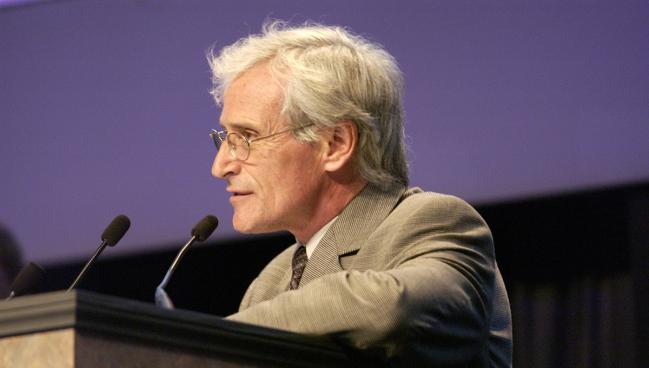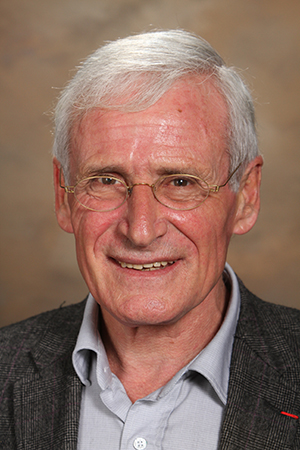Alain Cribier’s Death Mourned, His Legacy Celebrated Around the World
Famous for his “crazy dream” of implanting the world’s first TAVI, and loved for his energy and humility, Alain Cribier has died.

Cardiologists around the world are paying tribute to Alain Cribier, MD, who passed away Friday at the age of 79. Cribier is famous for having the “crazy dream” of implanting the world’s first transcatheter aortic valve in 2002 and has spent the last two decades urging out-of-the box cardiovascular innovation and promoting access to valvular care, even in parts of the world least able to afford it.
“Alain Cribier was arguably the ‘father’ of modern-era structural heart disease,” Martin Leon, MD (NewYork-Presbyterian/Columbia University Irving Medical Center, New York, NY), told TCTMD. “He was a caring physician, a humble humanitarian, a creative iconoclast, and an intuitive transcatheter operator—vital character and professional attributes, which led to the remarkable discovery of TAVI. His two most endearing qualities were passion and perseverance, which drove his pursuit of an unimaginable vision: the successful transcatheter treatment of critical aortic stenosis in an awake patient on a beating heart. Most important to me, he was a dear and loyal friend, and I shall miss him desperately.”
Cribier was the head of the department of cardiology at Rouen University Hospital in France for 20 years, becoming an emeritus professor and consultant in 2011. The press release from Rouen University announcing his passing calls Cribier “a true visionary, inventive and tenacious, always in action and yet accessible, smiling and available.”
Born in Paris in 1945, Cribier did his early schooling in the city, initially considering a career as a concert pianist before choosing instead to study medicine at the University of Paris—you can find him on YouTube delivering a vivacious performance of Rachmaninoff Prelude Op 23 no. 7 in C minor.
As a profile in PCRonline explains, Cribier was influenced early on by cardiothoracic surgeon Charles Dubost, with whose help he dedicated himself to being an “instrumentalist” and sharpened his early interest in device-based care. He pioneered the world’s first balloon valvuloplasty in 1985 and the first mitral commissurotomy in 1995.
In 1999, Cribier and Leon founded Percutaneous Valve Technologies (PVT) with engineers Stanley Rabinovich and Stanton J. Rowe. Three years later, Cribier, with Hélène Eltchaninoff, MD and Christophe Tron, MD, successfully implanted the first percutaneous aortic valve in a 57-year-old inoperable patient who’d been referred to Hôpital Charles Nicolle, in Rouen, for a balloon valvuloplasty. Few people attending any of the 20-year anniversary celebrations in 2022 of that first TAVI procedure can forget the now iconic, wide-eyed photo of Cribier, Eltchaninoff, and Tron deploying the valve. PVT was acquired by Edwards Lifesciences in 2004.
He has received many of the most prestigious awards in cardiology including the European Society of Cardiology (ESC) Gold Medal Award, the American College of Cardiology’s Presidential Citation, the EuroPCR Andreas Grüntzig Ethica Award, the TCT Career Achievement Award, the Texas Heart Institute’s Ray C. Fish Award for Scientific Achievement, the C3 meeting’s Legend of Medicine award, and the TCTAP Master of the Masters award, as well as several Lifetime Achievement Awards from Israel, Germany, Mexico, and India, among others. In France, Cribier was knighted with the Chevalier de l’Ordre de la Légion d’Honneur (Legion of Honor), Chevalier de l’Ordre des Palmes Académiques (Academic Palms), and the Grand Prize from the Institut de France Foundation.
Cribier’s Impact
Cribier’s impact will be felt for years to come, not only for his work as a pioneer but also for his humility and collegiality. “Professor Alain Cribier will forever remain an inspiration for present and future generations of cardiologists,” said Didier Tchétché, MD (Clinique Pasteur, Toulouse, France).
“A true pioneer in the field and the proof that we should always follow our ideas and dreams, as unfeasible or foolish as they may seem at the start. He will for eternity be the face of TAVI, the father of a true revolution in medicine. He was visionary, passionate, humble, and full of empathy,” Tchétché noted. “He said to me one day: ‘Be proud of what you have achieved, knowing your background and the hurdles you might have to overcome.’ What we should all be proud of is being the sons of Alain Cribier and continue his legacy: relentlessly innovate, try to be a better physician, respect others, and honestly transmit our knowledge. We will never forget you, Alain. Thank you for inspiring us.”
Today, the profound ways in which Cribier’s vision has upended and expanded the options for aortic valve disease care have been hailed by cardiologists and surgeons alike.
“Dr. Cribier’s contributions to the treatment of patients with valvular heart disease are monumental and his legacy will be long remembered,” said Michael Mack, MD (Baylor Scott & White Health, Plano, TX). “His first-in-human treatment by a transcatheter approach of a patient with aortic stenosis has caused a paradigm shift in the management of patients with structural heart disease.”
Bernard Prendergast, MD (Cleveland Clinic London, England), long-time course director for PCR London Valves, called Cribier a “fearless innovator—and not afraid to challenge the status quo—often in the heat of severe criticism.”
Cribier also remained “committed and dedicated to education on a global scale,” Prendergast noted. “Even long after clinical retirement, he was happy to lecture and support international symposia—only 2 weeks ago, I shared a virtual session with him in Moscow.”
Many may not know the extent to which Cribier was also a “tireless campaigner for increased access to innovation in low- and middle-income countries,” said Prendergast, pointing to his long-time support for the development of cheaper TAVI devices in developing nations and "previous attempts to develop reusable technologies for the transcatheter treatment of rheumatic mitral valve disease.”
Cribier was known for always being gracious in acknowledging the work of his colleagues and predecessors who helped influence and encourage him. He has credited percutaneous transluminal balloon angioplasty pioneer Andreas Grüntzig, MD, as an inspiration for what he called his “crazy dream” and “the stupidest idea ever submitted” of developing a percutaneous approach to valve replacement. But as he frequently reminded his peers, even the best ideas may take their time to find a foothold.
“Let us here quote André Gide,” Cribier wrote to commemorate the 15th anniversary of TAVI. “‘One doesn’t discover new lands without consenting to lose sight of the shore for a very long time.’”
Shelley Wood was the Editor-in-Chief of TCTMD and the Editorial Director at the Cardiovascular Research Foundation (CRF) from October 2015…
Read Full Bio


Comments